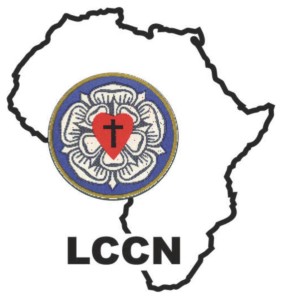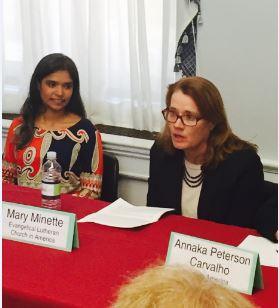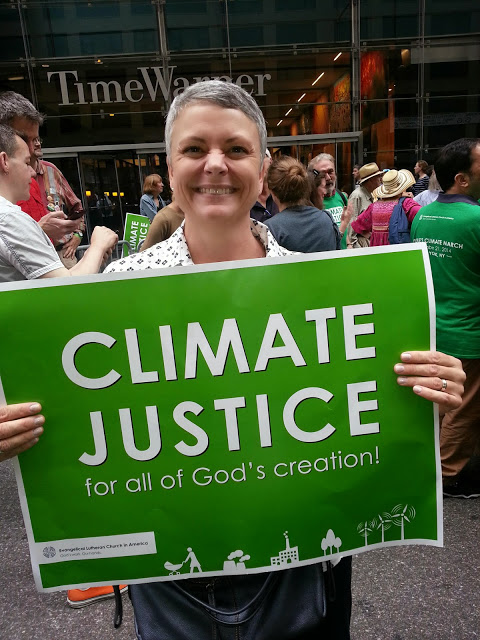A continuación ofrecemos un mensaje del reverendo Stephen Bouman, director ejecutivo de la Misión Congregacional y Sinodal de la ELCA
Todo viaje que valga la pena emprender empieza en el corazón, los pies le siguen después en el camino. Recibí una invitación de Mike Nevergall, de los Servicios Sociales Luteranos del Sur (LSSS, por sus siglas en inglés), para acompañarlos en su labor de dar la bienvenida a algunos de los muchos “menores sin acompañar” (niños de Dios) que cruzan nuestras fronteras en cantidades cada día mayores.
Durante cuatro años, el número de niños que migran de Centroamérica (en su mayoría de Honduras, Guatemala y El Salvador) y atraviesan México para llegar a EE.UU. se ha duplicado año con año. Este año son más de 57,000 y todavía no termina el año.
Le pedí a mi colega, el reverendo Rafael Malpica-Padilla, director de Misión Global, que me acompañe para liderar una visita a la frontera. (Rafael compartió la imagen gráfica de arriba que muestra la migración de la Sagrada Familia). Éste es un problema global/local que exige una conversación amplia y un entendimiento de los contextos en Centroamérica, México y Estados Unidos, así como de las condiciones que “empujan” y “jalan” esta migración. Rafael estuvo de acuerdo y nuestra delegación incluyó a personal de las unidades global y nacional de la ELCA, socios de la respuesta ante desastres y personal de nuestra oficina en Washington para la promoción de los derechos humanos. En Texas se nos unieron líderes de LSSS, pastores y líderes locales, y compañeros de México.
Nuestra visita arrancó en la oficina en Corpus Christi del programa de Familias de Acogida Temporal de la Oficina de Reubicación de Refugiados (ORR) de los Servicios Sociales Luteranos (LSS, por sus siglas en inglés). Tuvimos la oportunidad de conocer de primera mano la información sobre los niños sin acompañar que acaban en familias de acogida temporal. Visitamos el centro, incluyendo un salón donde los niños estaban tomando clase ese día. LSS dirige dos de estos centros: el de Corpus Christi, donde prestan servicio a 32 niños, y el de El Paso, donde atienden a 50. Estos niños en los hogares del grupo de Familias de Acogida Temporal son menores de 13 años.
Nos reunimos con una pareja (no se mencionan los nombres por razones de seguridad) que fueron los primeros padres temporales que se inscribieron cuando se abrió esta nueva oficina en abril. Desde entonces, más de 80 niños de Dios han sido recibidos en el hogar de esta familia de acogida.
“Los niños tienen miedo cuando llegan con nosotros. Pero ésta es su tierra prometida, si pensamos en todo por lo que han pasado”, dijeron. “Estos niños llegan con una fe sorprendente. Oramos con ellos. Algunos de estos niños se convierten en ‘pequeños evangelistas’ porque son acogidos aquí y se alimenta su fe”.
Hay un letrero en español delante de la casa de esta pareja. Dice: “La última parada de un largo viaje”.
Al entrar a un salón de clase, el problema se me presenta en toda su realidad. Aquí se encuentran los niños que habían estado en nuestros corazones.
Un niño de cinco años me sonrió. Es de El Salvador y cruzó la frontera con su abuela, de la que fue separado durante la apropiación del caso por parte de la Patrulla Fronteriza de EE.UU. Había dos hermanas de Honduras, de siete y ocho años de edad. Pensamos en nuestros hijos y nietos, de las edades de estos niños, mientras nos movíamos entre ellos hablando, escuchando, reflexionando. Nos encontramos en un entorno que se ha construido para darles seguridad a estos niños. No tomamos fotos de los niños. Las fotografías que tenemos son fotos “de archivo”. A los voluntarios no se les permite el contacto. Así que nuestros socios en LSS son nuestras manos y corazones. En los rostros de la familia de acogida y en los rostros de los niños vimos el rostro de Jesús.
A continuación visitamos el Refugio Infantil Bokenkamp en Corpus Christi, donde tuvimos la rara oportunidad de charlar uno a uno con los niños que se encuentran ahora ahí. Paul Hernández, director ejecutivo de Bokenkamp, y su personal tuvieron la amabilidad de mostrarnos el centro y responder las preguntas sobre cómo habían terminado allí los niños y a dónde irían cuando salieran del centro. Los niños del centro tienen entre 13 y 17 años de edad.
Había más de 100 niños sentados alrededor de las mesas en una gran sala. Yo fui de mesa en mesa. Entre mi pobre español y el limitado inglés de un miembro del personal que me acompañó, pudimos escuchar las historias de muchos niños. Mis preguntas fueron básicas: ¿De dónde eres? ¿Cuánto tiempo tardaste en llegar hasta aquí? ¿Cómo fue el viaje? ¿Qué te parece este sitio? ¿Dónde tienes familia? Las respuestas formaron un cuadro muy claro. ¿La principal razón por la que vinieron? “Violencia”. La primera persona con la que hablé, una niña de 13 años, fue muy clara: “La pandilla me iba a matar si me quedaba”.
Escuché historias de extorsión, de familiares asesinados, de amenazas. También escuché que los niños vinieron a reunirse con su familia. Cuando les pregunté qué les parecía este lugar, muchos sonrieron y dieron la misma respuesta. “Seguridad”.
Las historias sobre su viaje variaban de niño en niño. Vinieron en autobús, en tren, en una camioneta que conducían unos “coyotes”. Algunos caminaron muchas millas. Para algunos el viaje transcurrió, relativamente, sin nada que mencionar. Otros fueron robados, asaltados, fueron testigos de cosas malas que les sucedieron a otras personas. El personal nos dijo que muchas de las niñas estaban preparadas con algún tipo de control de la natalidad.
Muchos niños llegaron preparados con documentos para ayudarles a conseguir aquí la residencia. Cuando les pregunté dónde estaba viviendo su familia, las respuestas más frecuentes fueron: Nueva York, Maryland, Los Ángeles, Boston.
Hubo un momento en el que el Bronx se juntó con Texas y Honduras. En la Iglesia Luterana Transfiguration del Bronx, la congregación celebró alguna liturgia en el idioma garífuna. Los garífuna son un pueblo afrocaribeño que viven a lo largo de la costa de Honduras y Belice. Mientras conversaba con una bella niña de piel oscura y cabello grueso arreglado en trencitas, le pregunté: “¿Garífuna?” Su rostro se encendió en una enorme sonrisa y gritó: “¡Sí!” Le había encantado que la notaran, que la reconocieran en toda su particularidad.
Al siguiente día nos desplazamos en auto hasta el área fronteriza de McAllen. Es el epicentro del destino migratorio en la parte baja del valle del Río Grande. Visitamos la Iglesia Luterana St. John en San Juan, y nos reunimos con la pastora Sylvia de la Garza. La pastora Sylvia nos presentó a Danny Martínez, agente de la Patrulla Fronteriza de EE.UU., quien nos hizo una presentación de su trabajo.
Danny Martínez creció en San Juan y había sido maestro. Nos dijo que, en Tucson, el 80 por ciento de los migrantes recogidos por la Patrulla Fronteriza son mexicanos. En el Valle del Río Grande, el número es de 80 por ciento de “OTMs” (siglas de Other Than Mexicans, que se refiere a los nacionales de otros países además de México).
Debido a la ley de 2008 contra el tráfico de personas, la Patrulla Fronteriza no puede regresar a los niños sin documentos, sino que debe abrir un caso, con un juicio. Nos contó que la mayoría de los “coyotes” que facilitan el transporte sobre el terreno son también menores. Dijo que el tren que atraviesa México y va de Centroamérica a Texas es muy malo. Los niños van montados en el techo, donde algunos sufren robos, agresiones y violaciones, e incluso son arrojados del tren y mueren. El tren se descarriló ocho veces este último año. Al tren se le conoce como “la bestia”.
También tuvimos el privilegio de reunirnos con Jennifer Harbury, abogada y activista de los derechos humanos que desarrolla su actividad en el Valle del Río Grande, específicamente con casos donde están involucradas personas de Centroamérica. Escribió el libro Truth, Torture and the American Way (Verdad, tortura y el estilo de vida americano) para describir sus esfuerzos por averiguar qué le sucedió a su esposo Everado durante la guerra civil en Guatemala.
Jennifer contó la historia de un niño al que acogió, con lo que las diferentes cuestiones que rodean a los migrantes menores de edad se le hicieron personales y vívidas. En Honduras, las pandillas fueron a reclutar al niño cuando tenía aproximadamente 13 años. Lo golpearon, pero se negó a unírseles. La segunda vez lo atropellaron con un auto. Su madre le dio $30 dólares y le dijo que huyera. El ejército hondureño lo golpeó y lo robó en la frontera. Viajó en el techo del tren. Un cartel lo capturó en el norte de México. Fue recluido con muchos otros niños que atraparon para extorsionar a sus familias. Los niños se escaparon a la primera oportunidad y huyeron en todas direcciones. Casi se ahoga al cruzar el río a nado y lo recogió la Patrulla Fronteriza. Había sufrido abusos durante un mes en un centro de ORR y con una familia de acogida cuando lo conoció. Desde entonces, el joven ha dejado el alcohol, tiene un empleo y está cuidando de sus sobrinas y sobrinos. Jennifer habló de lo que impulsa a los niños a escaparse. Como dijo: “¡Me están lloviendo niños maltratados en mi patio!”
Luego visitamos la Iglesia Baptista Calvary y nos reunimos con el pastor Chad Mason y con Kathy Herzberg para hablar del personal de misiones. Chad nos contó cómo se utiliza a los voluntarios, qué donaciones se necesitan, cómo se coordina todo para ayudar a los refugiados después de que los dejan en la estación de autobuses de McAllen. Los voluntarios se reúnen con las familias en la estación de autobuses, los ayudan a comprar sus boletos (con bonos pagados por sus familias) y los llevan al centro de ayuda humanitaria en la parroquia católica de Sacred Heart, a dos cuadras de la estación. El centro es un ministerio ecuménico dirigido por la organización católica de beneficencia Catholic Charities donde los voluntarios ayudan con una variedad de servicios. El centro atiende a 140 personas al día. Los refugiados reciben dos mudas completas de ropa limpia, tienen la oportunidad de comer, ducharse y relajarse, y sus hijos reciben terapia de juego de la organización por los niños Save the Children. La hermana Leticia Benavides nos guió por el centro. Estábamos allí cuando llegó un grupo de madres y niños. Todos los que se encontraban en ese gran y cavernoso centro dejaron de lado sus ocupaciones y empezaron a aplaudir. “¡Bienvenidos!” Todos llegan aquí después de haber estado detenidos de 3 a 10 días. Están deshidratados y cansados, las lágrimas asoman a los ojos a la primera muestra genuina de hospitalidad que reciben después de tan larga jornada.
Al día siguiente nos reunimos en la Iglesia Luterana Our Savior en McAllen. Escuchamos a Omar Mixco hablar de la obra renovada de la organización sin fines de lucro La Frontera Ministries International y su meta de expandir sus oportunidades educativas y de inmersión. Omar es de Honduras y en la actualidad reside en la Ciudad de México como director ejecutivo de tiempo parcial de La Frontera. Ahora mismo está buscando involucrar a una variedad de socios a ambos lados de la frontera. Nos dijo que la ciudad de San Pedro Sula en Honduras es la ciudad más violenta del mundo. Está trabajando muy estrechamente con la Iglesia Luterana Our Savior; y Mary Lovig, de Our Savior, nos habló de la capacidad de los grupos para quedarse en la iglesia viviendo experiencias de inmersión y realizando viajes de misión.
Escuchamos al pastor Paul Bailie, de la Iglesia Luterana San Lucas en Eagle Pass, Texas, y supimos que la situación en Eagle Pass es similar y diferente, al mismo tiempo, de lo que habíamos experimentado en McAllen. Las dos zonas están a una distancia aproximada de cinco horas en auto. Paul está realizando viajes semanales a México para dar sermones en la iglesia hermana de Cristo Rey en Piedras Negras. El pastor Bailie describió una situación de constante pobreza. En su iglesia rezan juntas personas con y sin documentos legales. Paul tiene una sólida visión del ministerio y ha apostado por el liderazgo desarrollado a nivel local y su futuro sostenible.
Quiero terminar recordando a Moisés cuando era bebé, escondido en el agua entre los juncos para salvar su vida. Es necesario recordar la gran conspiración de las mujeres, tanto hebreas como egipcias –esclavas y libres– para salvar, alimentar y amar a ese niño. Que Dios nos conceda una conspiración así entre nosotros en nuestros días.
Si desea apoyar la obra que realiza la Respuesta Luterana ante Desastres entre los Migrantes Menores de Edad y sin Acompañamiento, por favor visite la página de donativos para la respuesta.
– Véase más en: http://www.elca.org/News-and-Events/blogs/ELCALutheranDisasterResponse/263






 Last week I was invited to speak at a Congressional briefing on the International Climate Negotiations in Lima, Peru, which are set to take place in December 2014. During this briefing, participants discussed the September Climate Leaders’ Summit in New York and looked to future opportunities for governmental, private sector, and civil society cooperation on climate change. I was asked to give the faith community’s perspective on the upcoming meeting in Lima. For this month’s reflection, I would like to share with you my statement from this event:
Last week I was invited to speak at a Congressional briefing on the International Climate Negotiations in Lima, Peru, which are set to take place in December 2014. During this briefing, participants discussed the September Climate Leaders’ Summit in New York and looked to future opportunities for governmental, private sector, and civil society cooperation on climate change. I was asked to give the faith community’s perspective on the upcoming meeting in Lima. For this month’s reflection, I would like to share with you my statement from this event: NGOs have been engaged for many years as well. However, with the Climate March in New York this past September, faith engagement and support for a global climate change agreement may have reached a tipping point. Thousands of people marched in NY out of their faith—we crowded into an entire city block during the march staging. Lutherans and Hindus, Muslims and Methodists, Catholics and Baptists joined together out of a shared concern for our future.
NGOs have been engaged for many years as well. However, with the Climate March in New York this past September, faith engagement and support for a global climate change agreement may have reached a tipping point. Thousands of people marched in NY out of their faith—we crowded into an entire city block during the march staging. Lutherans and Hindus, Muslims and Methodists, Catholics and Baptists joined together out of a shared concern for our future.